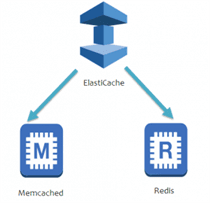Elastic Cache
ElastiCache improves the performance of web applications by allowing you to retrieve information from fast, managed in-memory cache instead of relying entirely on slower disk-based databases.
For example, if you are running an online business, customers continuously asking for the information of a particular product. Instead of front-end going and always asking information for a product, you can cache the data using Elasticache.
There are two types of Elasticache:
-
Memcached
-
Redis

Memcached
-
Amazon Elasticache for Memcached is a Memcached-compatible in-memory key-value store service which will be used as a cache.
-
It is an easy-to-use, high performance, in-memory data store.
-
It can be used as a cache or session store.
-
It is mainly used in real-time applications such as Web, Mobile Apps, Gaming, Ad-Tech, and E-Commerce.
Working of Memcached

-
Databases are used to store the data on disk or SSDs while Memcached keeps its data in memory by eliminating the need to access the disk.
-
Memcached uses the in-memory key-value store service that avoids the seek time delays and can access the data in microseconds.
-
It is a distributed service means that it can be scaled out by adding new nodes.
-
It is a multithreaded service means that it can be scaled up its compute capacity. As a result of this, its speed, scalability, simple design, efficient memory management and API support for most popular languages make Memcached a popular choice for caching use cases.
Redis
-
Redis stands for Remote Dictionary Server.
-
It is a fast, open-source, and in-memory key-value data store.
-
Its response time is in a millisecond, and also serves the millions of requests per second for real-time applications such as Gaming, AdTech, Financial services, Health care, and IoT.
-
It is used for caching, session management, gaming, leaderboards, real-time analytics, geospatial, etc.
Working of Redis

-
Redis keeps its data in-memory instead of storing the data in disk or SSDs. Therefore, it eliminates the need for accessing the data from the disk.
-
It avoids seek time delays, and data can be accessed in microseconds.
-
It is an open-source in-memory key-value data store that supports data structures such as sorted sets and lists.
Lab

